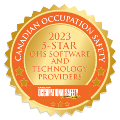Chemical Management Questions and Answers
We’ve compiled some commonly asked questions relating to chemical management, including WHMIS, SDS sheets, chemical hazards in the workplace, Transportation of Dangerous Goods and more. For more information regarding chemical management and solutions for your business, contact the team at Chemscape Safety Technologies today.
Questions About Chemical Hazards in The Workplace
Questions About Transportation of Dangerous Goods Training
Questions About WHMIS
What is WHMIS?
WHMIS is a Canada-wide system that stands for the Workplace Hazardous Materials Information System. WHMIS was designed so employers and workers have health and safety information regarding hazardous products used in the workplace. Employers must use this information as well as information specific to their workplace and train their employees on the safe use, handling and storage of hazardous products at their workplace.
What are WHMIS Manufacturer Responsibilities?
Manufacturers under WHMIS are expected to know the most about their chemical products. They are required to create WHMIS compliant container labels and SDSs. Manufacturers must actively distribute those SDSs. They may sell products directly to customers or through suppliers and distributors.
What are WHMIS Supplier Responsibilities?
Suppliers may have chemical products that are made in Canada or imported from other countries. They are required to classify each product as hazardous or not hazardous according to WHMIS regulations. Chemical products need a supplier label and SDS before it is shipped to customers.
What are WHMIS Employer Responsibilities?
As per WHMIS regulations and standards, employers are responsible for protecting their workers from health and safety hazards. Employers need to ensure their workers understand the hazards of the products in the workplace and understand how to protect themselves from those hazards. All hazardous products need labels and an up to date SDS. Employers need to provide education and training programs to their workers. Chemscape has prepared a WHMIS 2015 checklist to help employers audit their WHMIS program
What Are Worker Responsibilities Related to WHMIS?
Workers need to participate in WHMIS and chemical safety training. Workers should recognize hazards in the workplace and take steps to protect themselves. They are required to follow instructions and workplace procedures. Workers need to tell employers if they observe problems with labels and SDSs. They should understand how to work with the hazardous products at their workplace.
What Are Best Practices for WHMIS Training?
WHMIS training is frequently done when employees are hired as part of their orientation to a new company. Although there is no standard or expiration for WHMIS training industry best practices recommends WHMIS training should be ongoing, reviewed at least annually and adapt as hazards change in the workplace. A good WHMIS training program incorporates dialogue between the employer and employee with engagement and dialogue between management and front-line workers. WHMIS training should incorporate:
- Education of WHMIS basics
- Roles and responsibilities
- Classification and GHS pictogram awareness
- Safety Data Sheet education
- SDS labelling requirements
Training needs to be done to make WHMIS workplace specific and practical to the employees. Examples of regular training can include review of safe work procedures; emergency drills and standards; annual chemical inventory – SDS and labelling practices; and regular toolbox talks on chemical safety.
What are WHMIS supplier labels?
Labels need to be on every container of product you use on the job. WHMIS supplier labels alert you to the name of the product, the hazards of the product, what precautions you need to take to work safely with the product, and what to do in an emergency. Suppliers ship their product with a supplier label.
What is a WHMIS Workplace Label?
Suppliers may need to apply a WHMIS workplace label to a product, a workplace label may be required when:
- a hazardous product is made at the workplace and used at the same workplace
- a hazardous product is transferred to a secondary container
- a supplier label becomes damaged or unreadable
What are the WHMIS GHS Pictograms?
WHMIS GHS pictograms are graphic images that show you what type of hazard is present. They are organized according to the hazard group category. A chemical may have more than one pictogram. Click on this link to see a Chemscape poster of GHS Hazard Pictograms.
Questions About Safety Data Sheets
What is an SDS Sheet? What does SDS stand for?
A Safety Data Sheet, also known as an SDS is where you go if you need more information on a hazardous product. It gives you the facts on the product you are working with. The SDS helps you identify the hazardous materials of the product you are working with and gives you full details on the hazardous ingredients. The SDS provides instructions on how to work safely with a product. It describes the full steps you need to take if there is an emergency with the product.
What is the Difference Between SDS and MSDS?
SDS stands for safety data sheets and have 16-sections that are required as per the Globally Harmonized System (GHS) of classification and labelling of chemicals. MSDS stands for Material Safety Data Sheet and was the previous generation before the United Nations GHS SDS standard was adopted around the world. In North America only SDSs are compliant; as the USA, Canada and Mexico have transition to GHS SDS compliance. There still may be subtle differences between countries on the information in each section but the sections have been standardized to provide consistency in information on the hazards of chemicals around the world.
How Often Should SDS Sheets be Updated?
The requirements for SDS updates are dependent upon the jurisdiction you are working in. For Canada, you would want to look at the provincial/territory workplace WHMIS laws for any variation. For the USA you would refer to the OSHA Haz Com laws for your state as some states may have requirements that exceed federal standards. In general, it is the chemical manufacturers / suppliers’ responsibility to update the SDS when significant new information on the hazardous product occurs. Best practise is for worksites to do an annual chemical inventory check to ensure their SDS library is up to date and current. See the guidelines for updating SDSs in Canada for provincial and federal workplaces.
How Many Sections are in an SDS and What Is Included in the Information?
There are 16 sections in a safety data sheet:
Section 1: Product Identification
The product name on this section is always an exact match to the supplier label. Information in section 1 includes – the name of the product, the name and contact of the manufacturer/ supplier; recommended product use and restrictions are also listed in this section.
Section 2: Hazard Identification
The information on this section is very similar to what is on supplier labels. Information in section 2 includes – Hazard Signals, Signal Word, Hazard statements and Precautionary statements.
Section 3: Composition/Ingredients
The information on this section includes the Composition / Ingredients of the product. Information on section 3 – includes – list of ingredients, concentrations of each ingredient, CAS numbers, and trade secrets are also listed here.
Section 4: First Aid Measures
Steps you need take to treat a person who comes into contact with, ingests or inhales the product.
Section 5: Fire Fighting Measures
Details the appropriate firefighting measures to take as well as the type of fire extinguisher needed. Also included are the chemical hazards of a fire and what precautions and PPE fire fighters should wear.
Section 6: Accidental Release Measures
Discusses what the proper methods of containment and cleanup of a spill. If you need special emergency procedures to protect others including the environment, special equipment or PPE.
Section 7: Handling and Storage
Is about handling and storage. It gives you precautions for safe handling and safe storage requirements and identifies any incompatible materials.
Section 8: Exposure Controls/Personal Protection
Deals with exposure controls and personal protection. It gives you details on the personal protective equipment you need to wear. And describe the engineering controls that are needed to keep you working safely with the product. Exposure limits are also listed that are calculated by international organizations.
Section 9: Physical / Chemical Properties
Provides a complete technical description of the product. For example: state, colour, odour, flash point, boiling point, and freezing point.
Section 10: Stability and Reactivity
Is the product chemically stable? What materials will it react with? Does the product decompose into other hazardous substances? What conditions must be avoided?
Section 11: Toxicological Information
Focuses on health. It discusses long and short-term health effects. It explains which of your internal organs can become affected by exposure. If the product causes cancer, reproductive problems, or lead to chronic skin or lungs diseases.
Section 12: Ecological Information
Details if the product is toxic to the air, water or soil? If this has a short-term or long-term effect?
Section 13: Disposal Considerations
Tells you how to dispose of the product and its container. It describes any product residues and outlines any safe handling procedures.
Section 14: Transport Information
Tells you how to get the product to its destination safely. Regulatory information is listed like UN Number and shipping classes. Special transport considerations are listed here as well.
Section 15: Regulatory Information
If there are federal, provincial/state regulatory information for the health, safety or the environment. Content can apply to transporters, workers, suppliers and employers.
Section 16: Other Information
Preparation date of the SDS will be listed here.
What Products Require SDS Sheets?
Safety Data Sheets are mandatory for hazardous products. If a product arrives at the worksite without an SDS it needs to be quarantined until an SDS is obtained for the product.
Consumer products like WD-40 frequently purchase at a local hardware store may not be legislated to have an SDS but that does not mean the product is not hazardous and one may actually be available through the supplier. You may work with a product differently in the workplace then you do at home and this can affect the risk of the hazardous product and justify the availability of having an SDS on hand.
Who is Responsible for Creating SDS Sheets?
Manufacturers and suppliers of a hazardous chemical need to author a Safety Data Sheet for their product and make them available to customers and end users in their distribution chain. If a product has been imported from another country the distributor may be required to author a safety data sheet. Check with the local federal regulatory body in your country.
Who Should Have Access to Safety Data Sheets?
Anyone who is handling or storing the hazardous product should have access to the SDS. This may include employees who are transporting the hazardous product. Your SDSs also need to be made available to first responders in the event of an emergency. You can keep SDSs in an electronic version, on a mobile app or saved locally and printed.
How Should I Manage my SDSs?
Of course, Chemscape recommends outsourcing to sdsBinders for your Safety Data Sheet Management as it provides many advantages for you including:
- Access to your SDSs 24/7 either online or through our mobile app
- Access to sdsBinders massive library of current SDSs
- Always be compliant with your SDS Inventory
- Leave the work to sdsBinders to find your SDS documents
- Organize your SDS Binders how you want
- No limits to the number of users or binders
- Have a back-up file or printed copy of your SDSs
- Enjoy unlimited training and support on the sdsBinders
- Spend time managing other Health and Safety responsibilities and leave the SDS Management to Chemscape’ sdsBinders
Questions About Chemical Hazards in The Workplace
How Do You Identify Hazards in the Workplace?
A hazard is any potential source of harm, damage or adverse health effects on something or someone. To assess a hazard, you need to identify the hazards and risk factors that have the potential to do harm. Next you need to analyze and evaluate the risk associated with the hazard. Then you need to determine ways to eliminate that hazard or control the risk if the hazard cannot be eliminated.
What is a Chemical Hazard?
Chemicals have physical, health and environmental hazards. See the hazard categories for chemicals with the GHS pictograms that have been adopted by Canada (WHMIS) and the USA (HazCom). If you do not use, store, handle or dispose of chemicals according to their guidelines and unique properties there is potential for harmful and potentially fatal consequences.
How do Chemicals Affect your Health?
Chemicals can have short-term and long-term health effects on your body. It depends on many factors including how the chemical entered the body also known as the route of exposure. The four types of exposure include inhalation, ingestion, skin contact, skin absorption and injection. An injury like a chemical burn is immediate. Long term exposure and inhalation of silica dust can cause a lung disease called silicosis. Information on the health hazards and effects of a chemical is found in its Safety Data Sheet. This is why its important to have workers trained on the chemicals they handle and an SDS readily available in an emergency so you can refer to the SDS for more information.
Where Do I Find Information on the Health Hazards of a Chemical?
The health hazard information is always found on section 2 of the chemical’s Safety Data Sheet. Information on the classification of the chemical, its related pictograms, and hazard statements are listed on this section of the SDS.
What is the Hierarchy of Control?
The hierarchy of control is the cornerstone of good chemical management. Chemscape follows this practise in the philosophy of their chemical management systems CHAMP. Good chemical management always look to control the chemical hazard starting at the top of the hierarchy using elimination, then substitution, engineering controls, administrative controls and finally with PPE. Elimination is considered the most effective method of chemical control and PPE is considered the least effective method of control.
Questions About Transportation of Dangerous Goods
What Is TDG (Transportation of Dangerous Goods) Training?
TDG stands for the Transportation of Dangerous Goods. TDG is a federal Canadian standard that establishes rules and safety requirements for the movement of dangerous goods by rail, air, road and water. TDG has a list of substances that are considered dangerous goods. Training is a very important element of TDG. Employees must receive TDG training before they handle, ship or transport any dangerous goods in Canada.
TDG Training should include an understanding of the following:
- 9 Classifications of dangerous goods
- Shipping Names, Classes, UN Numbers and Packing Groups
- Use of Schedule 1, 2, 3
- Shipping Documentation
- TDG Safety Placards
- Selection and Means of containment
- ERAP
- Reporting requirements
- Proper use of equipment to handle and transport
- Emergencies and accidental releases
- Mixed loads and Special Situations
How Long is a TDG Training Certificate Valid For?
A TDG training certificate for road transport is valid for 36 months or 3 years from the date of issue. If you change jobs or transfer employers, you will need to retrain as TDG certification is not transferable between employers.
Who Requires TDG Training?
The following 3 groups of people should be trained in TDG regulations and workplace practices related to TDG. These groups include:
1. Consignors
Anyone who ships the dangerous goods such as manufacturers, distributors, or a member of the public.
2. Carriers
Anyone who transports the dangerous goods such as trucking companies, air cargo companies, and marine shipping companies.
3. Consignees
Anyone who receives the dangerous goods from a consignor.
Where Should Your TDG Certificate Be Kept?
A person should have a certificate available to present (i.e. wallet sized certificate) if requested by a TDG Inspector. Inspection and enforcement of TDG is carried out by TDG inspectors on the road.



